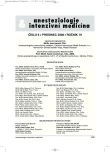Permissive hypercapnia
Authors:
Šrámek Vladimír
Authors‘ workplace:
Fakultní nemocnice u svaté Anny v Brně, Lékařská fakulta Masarykovy univerzity
Published in:
Anest. intenziv. Med., 19, 2008, č. 6, s. 319-322
Category:
Anaesthesiology - Review Article
Overview
The review summarizes the fundamentals of carbon dioxide homeostasis. The impact of hypercapnia on the vital organs, organ systems, microcirculation and cellular function are described. Hypercapnia is discussed in the context of protective ventilation and respiratory acidosis. The current recommendations in protective ventilation of the critically ill and the contraindications to permissive hypercapnia are listed.
Key words:
carbon dioxide – hypercapnia – protective ventilation – ARDS
Sources
1. Mazzeo, A. T., Spada, A., Praticò, C. et al. Hypercapnia: what is the limit in paediatric patients? A case of near-fatal asthma successfully treated by multipharmacological approach. Paediatr. Anaesth., 2004, 14, p. 596–603.
2. Urwin, L., Murphy, R., Robertson, C. et al. A case of extreme hypercapnia: implications for the prehospital and accident and emergency department management of acutely dyspnoeic patients. Emerg. Med. J., 2004, 21, p. 119–120.
3. Hickling, K. G., Henderson, S. J., Jackson, R. Low mortality associated with low volume pressure limited ventilation with permissive hypercapnia in severe adult respiratory distress syndrome. Intensive Care Med., 1990, 16, p. 372–377.
4. Hickling, K. G., Walsh, J., Henderson, S. et al. Low mortality rate in adult respiratory distress syndrome using low-volume, pressure-limited ventilation with permissive hypercapnia: a prospective study. Crit. Care Med., 1994, 22, p. 1568–1578.
5. Kuiper, J. W., Groeneveld, A. B., Slutsky, A. S. et al. Mechanical ventilation and acute renal failure. Crit. Care Med., 2005, 33, p. 1408–1415.
6. Wang, Z., Su, F., Bruhn, A. et al. Acute hypercapnia improves indices of tissue oxygenation more than dobutamine in septic shock. Am. J. Respir. Crit. Care Med., 2008, 177, p. 178–183.
7. Komori, M., Takada, K., Tomizawa, Y. et al. Permissive range of hypercapnia for improved peripheral microcirculation and cardiac output in rabbits. Crit. Care Med., 2007, 35, p. 2171–2175.
8. Dhuper, S., Maggiore, D., Chung, V. et al. Profile of near-fatal asthma in an inner-city hospital. Chest, 2003, 124, p. 1880–1884.
9. Gupta, D., Keogh, B., Chung, K. F. et al. Characteristics and outcome for admissions to adult, general critical care units with acute severe asthma: a secondary analysis of the ICNARC Case Mix Programme Database. Crit. Care, 2004, 8, p. R112–121.
10. Kregenow, D. A., Rubenfeld, G. D., Hudson, L. D. et al. Hypercapnic acidosis and mortality in acute lung injury. Crit. Care Med., 2006, 34, p. 1–7.
11. Gajic, O., Frutos-Vivar, F., Esteban, A. et al. Ventilator settings as a risk factor for acute respiratory distress syndrome in mechanically ventilated patients. Intensive Care Med., 2005, 31, p. 922–926.
12. Jardin, F., Vieillard-Baron, A. Is there a safe plateau pressure in ARDS? The right heart only knows. Intensive Care Med., 2007, 33, p. 444–447.
13. Hager, D. N., Krishnan, J. A., Hayden, D. L. et al. ARDS Clinical Trials Network.Tidal volume reduction in patients with acute lung injury when plateau pressures are not high. Am. J. Respir. Crit. Care Med., 2005, 172, p. 1241–1245.
14. Brower, R. G., Lanken, P. N., MacIntyre, N. et al. National Heart, Lung, and Blood Institute ARDS Clinical Trials Network.Higher versus lower positive end-expiratory pressures in patients with the acute respiratory distress syndrome. N. Engl. J. Med., 2004, 351, p. 327–336.
15. Meade, M. O., Cook, D. J., Guyatt, G. H. et al. Lung Open Ventilation Study Investigators. Ventilation strategy using low tidal volumes, recruitment maneuvers, and high positive end--expiratory pressure for acute lung injury and acute respiratory distress syndrome: a randomized controlled trial. JAMA, 2008, 299, p. 637–645.
16. Villar, J., Kacmarek, R. M., Pérez-Méndez, L. et al. A high positive end-expiratory pressure, low tidal volume ventilatory strategy improves outcome in persistent acute respiratory distress syndrome: a randomized, controlled trial. Crit. Care Med., 2006, 34, p. 1311–1318.
17. Mercat, A., Richard, J. C., Vielle, B. et al. Expiratory Pressure (Express) Study Group. Positive end-expiratory pressure setting in adults with acute lung injury and acute respiratory distress syndrome: a randomized controlled trial. JAMA, 2008, 299, p. 646–655.
18. Dreyfuss, D., Soler, P., Basset, G. et al. High inflation pressure pulmonary edema. Respective effects of high airway pressure, high tidal volume, and positive end-expiratory pressure. Am. Rev. Respir. Dis., 1988, 137, p. 1159–1164.
19. Muscedere, J. G., Mullen, J. B., Gan, K. et al. Tidal ventilation at low airway pressures can augment lung injury. Am. J. Respir. Crit. Care Med., 1994, 149, p. 1327–1334.
Doporučená literatura
Kavanagh, B. P. et al. Hypercapnia: permissive and therapeutic. Minerva Anesthesiol., 2006, 72, p. 67–76.
Chonghaile, M. N. et al. Permissive hypercapnia: role in protective lung ventilatory strategie. Curr. Opin. Crit. Care, 2005, 11, p. 56–62.
Laffey, J. G. et al. Permissive hypercapnia – role in protective lung ventilatory strategies. Intensive Care Med., 2004, 30, p. 347–356.
Hasset, P. et al. Hyperkapnia: Permissive, Therapeutic, or Not at All? In Vincent, J. L. (Ed). Yearbook of Intensive Care and Emergency Medicine, 2008, p. 269–281.
Manca, T. et al. The Cardiopulmory Effects of Hypercapnia. In Vincent, J. L. (Ed). Yearbook of Intensive Care and Emergency Medicine, 2008, p. 282–289.
Labels
Anaesthesiology, Resuscitation and Inten Intensive Care MedicineArticle was published in
Anaesthesiology and Intensive Care Medicine

2008 Issue 6
Most read in this issue
- Permissive hypercapnia
- Corticosteroids in the treatment of ALI/ARDS
- The first combined heart-lung transplantation in the Czech Republic from the perspective of an anaesthesiologist and an intensivist
- Power M-mode in Transcranial Doppler (TCD) facilitates the diagnostic process in neurointensive care – case reports
